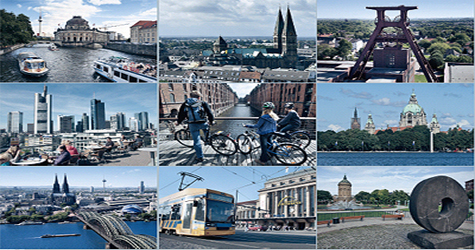Siemens publishes Green City Index – First environmental study of twelve major German cities.
Frankfurt / Main, Germany, 2011-Jun-21
Compared to other European cities, Germany’s urban centers are better than average and, in fact, among the best when it comes to protecting the climate and the environment. This is the finding of the German Green City Index, an urban study commissioned by Siemens from the Economist Intelligence Unit (EIU), an independent research institute. A total of eight environmental categories were examined in the study. Ten of the twelve German cities come in “above average,” the second-highest of five possible rankings and a better showing than that achieved by the majority of the 29 major European cities evaluated in the 2009 European Green City Index. German cities show particularly strong performances in the areas of environmental strategies, water, recycling and energy-efficient buildings. However, there is still room for improvement – for instance, in the area of CO2 emissions.
“The study provides local decision-makers with an objective basis for discussing environmental protection. As the world’s leading provider of green technologies, we can – and will – help cities extend and improve their infrastructures in ways that are sustainable,” says Rudolf Martin Siegers, head of Siemens Germany.
Today, three-quarters of all Germans live in cities – a proportion that is expected to increase another ten percent by 2050. Such growth is a tremendous challenge for urban infrastructures and environmental protection. In Germany, too, the fight against climate change will be decided in cities.
To gain insights into the environmental strategies and the successes and challenges in the twelve German cities analyzed, eight environmental areas – CO2, energy, buildings, transport, water, waste and land use, air quality and environmental governance – were evaluated both quantitatively and qualitatively. The methodology used in the Green City Index was developed by the EIU together with independent urban sustainability experts. The Index, which now covers more than 100 cities, is the only study of its kind in the world. Germany is the fourth region – after Europe, Latin America and Asia – for which Siemens has commissioned a Green City Index.
Key findings of the German Green City Index
Compared to the rest of Europe, German cities rank close together and are very similar in performance. This is partly due to legislation: the directing and implementing of sustainable urban development policies has a long history in Germany. In addition, Germans have a high degree of environmental awareness. “The study also shows that environmental protection is not a luxury,” says Emily Jackson, project manager at the EIU. “Despite sometimes considerable differences among the cities in terms of income, population, geographical location and amount of industry – none of these factors have a measurable effect on a city’s ranking in the Index.”
In the German cities analyzed, buildings use 20 percent less energy than those in neighboring European countries. This is the effect, among other things, of strict regulations for energy efficiency and of energy-saving building renovation.
The German cities also score somewhat better than their European counterparts in terms of energy efficiency. However, the European cities are significantly ahead in terms of the proportion of renewable energies used.
In transport, Germany pursues green transportation policies. But despite that fact, many Germans still rely on automobiles. Nearly 50 percent continue to travel to work by private car, although the networks of cycle paths and public transport are more extensive than in Europe.
In terms of water use, the German cities studied are at the top. At 59m3 per capita, annual consumption is about half that in other European metropolises (107m3). Closely monitored water networks and a relatively high water price encourage the careful use of this valuable resource.
German cities are also at the top when it comes to recycling: despite generating a higher amount of waste than other European urban centers, German cities recycle about three times as much waste material.
In all the German regions assessed, air quality is promoted by quality targets and air quality policies. Even cities with relatively high levels of industry or traffic volumes perform well.
However, the greatest challenge facing German cities is CO2 emissions. Here, German cities are performing worse than their European counterparts, primarily due to the relatively high proportion of coal used in power generation.
More information on the Green City Index is available at: www.siemens.com/press/germangreencityindex








